Ambulance
Car Show
Ambulance
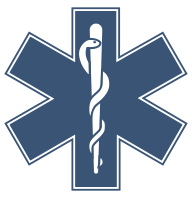
An ambulance is a
vehicle designated for the transport of sick or injured people. The first
ambulances called by that name were horse ambulances used in the American Civil
War. The first practical ambulances were created by Dominique Jean Larrey, a
French surgeon (1766–1842), for use in the Napoleonic Wars. Modern-day ambulances are typically large
automobiles
on a van or light
truck chassis.
However, an ambulance can be any vehicle, including a
bus, helicopter, or even a hospital ship. During the 1960s and 1970s,
station wagons were used in some American cities (despite their limited
space) and can be seen in
motion pictures from that period.
In some countries civilian ambulances may use the symbol referred to as the
"Star of Life," a blue six point star, originally designed and governed by the
U.S. National Highway Traffic Safety Administration (NHTSA).
Any unit displaying this star is said to be qualified to render its specific
level of emergency care.
Under the
laws of war, an ambulance marked by a red cross is not to be fired on and is to
be permitted to carry out its duties in spite of the fighting. An ambulance may
not mount weapons, although the Israeli EMS has produced a "tankbulance" that
combines a Merkava main battle tank with ambulance features (see below).
Ambulances in North America
Ambulance types
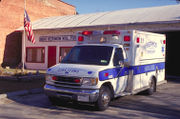 A typical Type III Ambulance. Note that the front of the ambulance is a van,
while the patient-care compartment is in the box-like module. This ambulance is
run by the
Harmon, NY volunteer fire department.
A typical Type III Ambulance. Note that the front of the ambulance is a van,
while the patient-care compartment is in the box-like module. This ambulance is
run by the
Harmon, NY volunteer fire department.
Ambulances in both the
United States and Canada are
defined by KKK-1822E requirements which defines several categories of
ambulances.
- Type I Ambulances are based on the chassis-cabs of light duty
pickup-trucks,
- Type II Ambulances are based in modern passenger/cargo vans,
- Type III Ambulances are based on chassis-cabs of light duty vans,
- Extreme Duty versions of both Type I and Type III are also now
authorized based on the chassis-cabs of medium duty truck chassis.
Note that Type I's and Type III's are often called boxes by their
crews with Type II's being called vanbulances; ambulances are also
referred to as buses (which some EMTs and paramedics consider to be
derogatory), mods or modulars (if type I or III), rigs etc.
- There are also
fly-cars,
which are large cars or SUVs. These units cannot provide patient transport,
but are used variously by supervisors or as a source of additional
personnel.
- A new and emerging industry, specifically in the Province of Ontario, is
non-emergency patient transfers. Many companies who specialize in these
transfers are creating their own vehicles with ambulance type equipment, but
without emergency lights and sirens. One
example is from Voyageur Transportation, based on the Dodge Sprinter
Cargo Chassis. Aboutown Medical Transfer, has several varieties based on
GMC/Chevy passenger chassis.
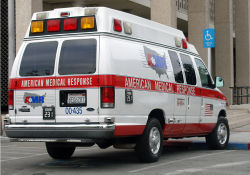 A typical Type II ambulance. Note how, in contrast to the Type III ambulance
shown above, the basic shape of this ambulance is that of a standard full-sized
van with a raised roof. This ambulance is operated by American Medical Response,
a commercial for-profit company.
A typical Type II ambulance. Note how, in contrast to the Type III ambulance
shown above, the basic shape of this ambulance is that of a standard full-sized
van with a raised roof. This ambulance is operated by American Medical Response,
a commercial for-profit company.
Ambulance Providers
Ambulance service providers come in several types in the USA:
1. Volunteer Ambulance Corps (VAC) or services - function similar to
Volunteer Fire Companies. St. John Ambulance is the most common, providing
world-wide service in locations ranging from New York City **Sorry, this is
incorrect. There is a hospital in Elmhurst, Queens, NYC, called SVCMC St. John's
Queens Hospital, which has an ambulance department which provides several units
to the NYC 911 EMS system, however it has no relation to the UK's St. John
Ambulance organization.** to small rural communites, but many VACs are
independent corporations. VACs may be community owned or privately owned, but
are typically organised as non-profit organizations. VACs may also be part of
Volunteer Fire Companies; in some of these cases, EMTs and
drivers are also firefighters. Up until recently, Harbor City Volunteer
Ambulance Squad (HCVAS) in Melbourne, Florida was the largest volunteer
ambulance squad in the United States.
2. Private Ambulance Service - Normal commercial companies with paid
employees, of which the largest is AMR (American
Medical Response). While many private companies provide inter-facility
patient transfer, many communities' 911 needs are served by private services.
3. Municipal Third Service - Operate as a third service alongside fire and
police departments. These are more likely to be found in areas with a high
population density, such as a city or metropolitan area.
4. Municipal - Usually fire department owned and operated, though some
systems are police department owned and operated.
5. Combined - these are full service emergency service agencies such as
airport and college
public safety offices. Some smaller towns and cities may also have them.
Generally all personnel are crosstrained as EMT's/Firefighter/peace officer.
6. Hospital Based - Ambulance service such as ALS, BLS and CCT are offered by
profit and non profit hospitals as a service to the community. Often these
services do not support themselves and are funded by the hospital. Such as
Enloe Medical Center out of Chico, Ca.
Ambulances in France
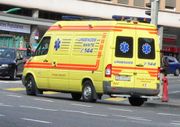 Ambulance in
Lausanne (Switzerland)
Ambulance in
Lausanne (Switzerland)
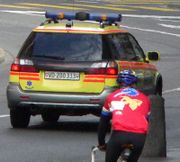 A SMUR car in
Lausanne
A SMUR car in
Lausanne
In France, the most general term is "vehicle adapted to patient transport",
the term "ambulance" only applies for some categories of patient transport
vehicles.
The word "ambulance" is reserved to transportation on medical prescription,
including oral prescription in case of emergency. It does not apply to first
responders vehicles (most of times
firefighters), although they also transport casualties; their vehicles are
called VSAV–véhicule de secours et d'assistance aux victimes (rescue and
assistance to casualties vehicle), or VPS–véhicules de premiers secours
(first responders vehicles) in case of volunteers from associations. The VSAV
and VPS are considered as vectors that bring rescue workers and devices onsite,
the evacuation being only the logical following of this intervention but not
their main duty.
There are therefore two kinds of ambulance providers: hospitals and private
companies.
The reglementation classifies the patient transport vehicles in four types:
- A-type : ambulance for rescue and emergency care (ambulance de
secours et de soins d'urgence–Assu) : in these ambulances, the personnel
can stand; only these vehicles can be used for emergency (sanitary duty and
H-MICU, see below) ;
- B-type : rescue and assistance to casualty vehicles (VSAV), i.e. first
responders vehicles, very close to the A-type ;
- C-type : ambulance : the personnel cannot stand, it only allows the
transport of a lying patient and of a sitting ambulance technician besides ;
due to the lack of room, cares cannot be performed during the transport
(these vehicles tend to disappear) ;
- D -type: light vehicle (véhicule sanitaire léger–VSL) : normal
car without any specific equipment, for patient who can sit.
The A, B and C-types are called "specially equipped" vehicles, and must
follow the
NF
EN 1789 standard (December 1999).
First responders vehicles
A VSAV has three professional1 CFR onboard, a VPS has five
volunteer CFR.
The
first responders of the VSAV and VPS are called secouristes and have
60 hours of initial education (plus additional continuous education) and perform
non-medical, non-invasive acts. They use splints (including
cervical collars, long spine boards and vacuum mattresses), oxygen first aid,
and make the casualty lifting.
Note
- some firefighters are not full-time professionals; they are called "pompiers
volontaires", but they are paid for their work, whereas the volunteers
from CFR associations (secouristes bénévoles) are not paid.
Hospital ambulances
There are two kind of hospital ambulances:
- internal ambulances, which drive the patients from a building to the
other; these are sometimes simple vehicles without any medical equipment
when the transport do not require any care (these are always very short
transportations).
- the UMH–unité mobile hospitalière (H-MICU–hospital medical
intensive care unit) from the
SMURr–service mobile d'urgence et de réanimation (mobile
emergency resuscitation service) : an ambulance with an
MD, a nurse
and an ambulance technician that do pre-hospital intervention and
interhospital transportation under intensive care.
The H-MICU is often a light rapid-intervention vehicle, i.e. a car carrying
the personnel and the material to the casualty; the transport itself is made
with a VSAV or a private ambulance equipped with the medical unit.
Special warning devices and traffic law
The H-MICU (A-type) and VSAV (B-type) have a blue rotating light and a
two-tones siren (high-low-high-low-high-low...). When these special warning
devices are on and when the emergency of the mission justifies it and
as long as they do not endanger the life of other people, the traffic law allow
them to get rid of certain limitations such as speed limits, direction of
driving, priorities and traffic light. In most states, this allows ambulances to
travel no more than 5 miles per hour above the posted speed limit. Also, when
approaching a red light, the ambulance must first stop, determine the
intersection is clear, and then may proceed regardless of what color the light
is.
The ambulance of private companies (A- and C-type) have a blue flashing light
and a three-tones siren (high-low-high...high-low-high...). When these special
warning devices are on and when the emergency of the mission justifies it
and as long as they do not endanger the life of other people, traffic
laws allow them to get rid of certain limitations such as speed limits while
respecting lane priorities and traffic lights.
Ambulances in the UK
In the
UK, ambulance services are provided under the National Health Service through
local ambulance 'trusts'. Each trust is specific to a county or area, and so the
country is divided across a number of ambulance trusts, in a similar way to the
British Police are. There are 31 ambulance trusts in England but there are
likely to be several mergers in 2006 which will result in fewer trusts.
Most trusts offer three levels of personnel for service: care assistants,
technicians and paramedics. Care assistants operate PTS (Patient Transport Services), which is largely
concerned with the moving of patients between hospital and home. Technicians and
paramedics crew the emergency ambulances, providing more urgent transport and
also paramedical care of casualties. Occasionally, when not attending emergency
incidents, technicians and paramedics may help out with PTS duties. Ambulance
Trust's performance is measured. The Governments targets are to reach 75% of
Category A (life threatening) calls within 8 minutes. A number of initiatives
have been introduced to assist meeting these targets, including Rapid Responders
and Community Responders.
Ambulance crews work a shift rota, and working nights and public holidays is
seen as part of the job. Many people start out in a PTS role to gain experience
of patient care, and then progress onto additional technician training at a
later date. This has always been the classic method of entry into the ambulance
service, although more recently some Universities have started to offer
paramedicine degrees, with guaranteed direct entry into technician status on completion.
These courses are somewhat controversial, with some more experienced ambulance
staff arguing that such a fast-track approach misses the experience of PTS where
recruits learn vital interpersonal skills. Direct entry to paramedic is not
available, and can only be achieved via the technician route. Many trusts
receive several hundred applicants per place, and this allows them to be very
discriminating.
Technician training in many trusts is a 10 week course, usually residential.
The IHCD division of Edexcel
provides the qualifications for ambulance technicians and paramedics, and
qualifiers become known as "state registered" or "IHCD registered". Without this
registration, crewing of emergency vehicles or administration of certain medical
techniques is forbidden.
Private ambulance services are becoming more common in the UK, along with the
traditional voluntary sectors, such as the
Red Cross and St. John Ambulance. However both the voluntary and private
services tend to be concerned with PTS, and it is rare (although not unheard of)
to find an emergency being attended by a non-NHS ambulance. The relevant UK
legislation applies to all ambulances with no discrimination as to who owns or
operates them. The majority of UK Private Ambulance Services are members of the
British Ambulance Association.
In the UK, a minority of NHS ambulance staff are highly critical of the
voluntary and private services, and there may exist an elitist attitude within
some trusts. This may stem from hatred incurred during the various ambulance
strike actions, where private, voluntary and military ambulance services have
stepped in to provide cover, being referred to as "scabs".
Most trusts are more positive about the additional services, even welcoming them
as a means to reduce their own workload.
Ambulances is Germany and Austria
 A german ambulance and the smaller emergency physician car with blue signal
lights on.
A german ambulance and the smaller emergency physician car with blue signal
lights on.
In the german-speaking countries of Germany and Austria preclinical care is
not only provided by non-physician staff (Rettungssanitäter or Retttungassistent),
but also by specially trained emergency phyicians (called "Notarzt"). Therefore
there are different types of ambulances. A few years ago, an ambulance that was
sent to a potential life-threatening situation (e.g. cardiac arrest), was
usually staffed with two paramedics and one physician. This system's
disadvantage was that if the situation wasn't that life-threatening at all (and
therefore no emergency physician would be needed) the ambulance staff had to
treat the patient and wasn't therefore able to respond to situations where they
really would be needed. In the last few year the so-called "Rendezvous-System"
took over, where the emergency physician is driven to the scene by a separate
car (usually a SUV) and the paramedics with the ambulance. Therefore, if there
is not physician needed, the doctor can leave and let the paramedics take care
of the patient or - in the opposite situation - if an ambulance is deployed to a
situation which didn't sound that serious to the operator, the paramedics can
call for reinforcements and the emergency physician could respond. Also, the
driver of the emergency phycician's car is usually a trained EMT too, so in case
there is a very serios situation (resuscitation, heavy trauma), there are more
trained people on the scene.
Military ambulances
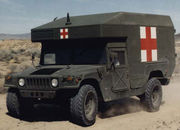 A
US M997
Ambulance
A
US M997
Ambulance
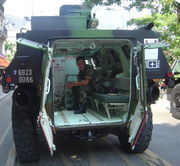 Inside of an ambulance
VAB of the French Army.
Inside of an ambulance
VAB of the French Army.
Military ambulances include both regular ambulances painted in olive (though
some may be white, like civil ones. The British
Army Medical Corps has a fleet of white ambulances, based on production trucks)
and armed ambulances based upon AFVs. Military helicopters often function as
aerial ambulances, since they are extremely useful for MEDEVAC.
Due to the high level of danger in battle-fields, military ambulances are
often armored, or based upon
armored fighting vehicles (AFV). Since laws of war demand ambulances not to
mount any weapon, an ambulance AFV is disarmed and marked by a red cross
or another accepted medical marking.
Recently, Israel has modified some of its Merkava main battle tanks with
ambulance features in order to allow rescue operations to take place under heavy
fire in urban warfare. The modifications were made following a failed rescue
attempt in which Palestinian gunmen killed two soldiers who aided a Palestinian
woman in Rafah. Since M-113 armoured personnel carriers and regular up-armored
ambulances are not protected enough against anti-tank weapons and improvised
explosive devices, commonly used by Palestinian militants against both military
and civilian Israeli vehicles, it was decided to use the Merkava tank, because
it features heavy armor and a rear door enabling the evacuation of critically
wounded soldiers. Though ambulances may not carry weapons, Israel did not remove the Merkava's weaponry, claiming that
Palestinian militants do not adhere to international law by firing on
ambulances. Therefore, it becomes necessary to protect troops that come to aid
the wounded.
External links
References
Home | Up | Jam sandwich | Panda car | Ambulance | Police car | Paddywagon | SWAT van
Car Show, made by MultiMedia | Free content and software
This guide is licensed under the GNU
Free Documentation License. It uses material from the Wikipedia.
|







